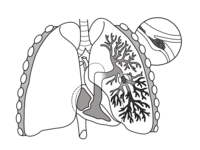
Photo from wikipedia
Objective Stroke caused from large vessel occlusion (LVO) has emerged as the most common stroke subtype worldwide. Intravenous tissue plasminogen activator administration (IV-tPA) and additional intraarterial thrombectomy (IA-Tx) is regarded… Click to show full abstract
Objective Stroke caused from large vessel occlusion (LVO) has emerged as the most common stroke subtype worldwide. Intravenous tissue plasminogen activator administration (IV-tPA) and additional intraarterial thrombectomy (IA-Tx) is regarded as standard treatment. In this study, the authors try to find the early recanalization rate of IV-tPA in LVO stroke patients. Methods Total 300 patients undertook IA-Tx with confirmed anterior circulation LVO, were analyzed retrospectively. Brain computed tomography angiography (CTA) was the initial imaging study and acute stroke magnetic resonance angiography (MRA) followed after finished IV-tPA. Early recanalization rate was evaluated by acute stroke MRA within 2 hours after the IV-tPA. In 167 patients undertook IV-tPA only and 133 non-recanalized patients by IV-tPA, additional IA-Tx tried (IV-tPA + IA-Tx group). And 131 patients, non-recanalized by IV-tPA (IV-tPA group) additional IA-Tx recommend and tried according to the patient condition and compliance. Results Early recanalization rate of LVO after IV-tPA was 12.0% (36/300). In recanalized patients, favorable outcome (modified Rankin Scale, 0–2) was 69.4% (25/36) while it was 32.1% (42/131, p<0.001) in non-recanalized patients. Among 133 patients, nonrecanalized after intravenous recombinant tissue plasminogen activator and undertook additional IA-Tx, the clinical outcome was better than not undertaken additional IA-Tx (favorable outcome was 42.9% vs. 32.1%, p=0.046). Analysis according to the perfusion/diffusion (P/D)-mismatching or not, in patient with IV-tPA with IA-Tx (133 patients), favorable outcome was higher in P/ D-mismatching patient (52/104; 50.0%) than P/D-matching patients (5/29; 17.2%; p=0.001). Which treatment tired, P/D-mismatching was favored in clinical outcome (iv-tPA only, p=0.008 and IV-tPA with IA-Tx, p=0.001). Conclusion The P/D-mismatching influences on the recanalization and clinical outcomes of IV-tPA and IA-Tx. The authors would like to propose that we had better prepare IA-Tx when LVO is diagnosed on initial diagnostic imaging. Furthermore, if the patient shows P/D-mismatching on MRA after IV-tPA, additional IA-Tx improves treatment results and lessen the futile recanalization.
Journal Title: Journal of Korean Neurosurgical Society
Year Published: 2023
Link to full text (if available)
Share on Social Media: Sign Up to like & get
recommendations!